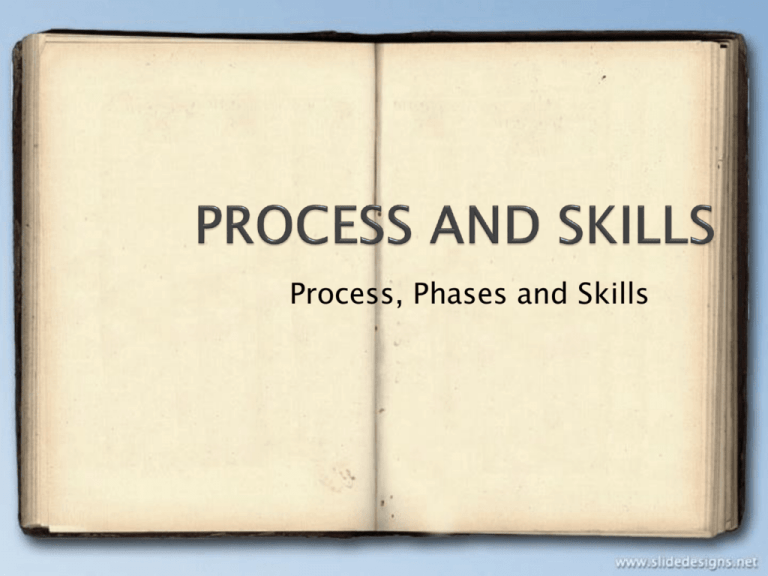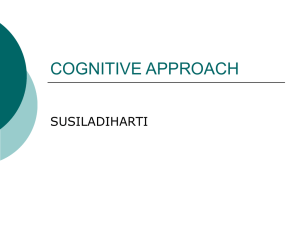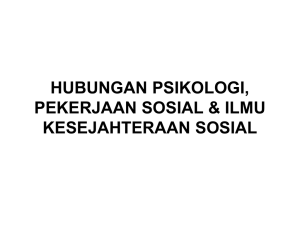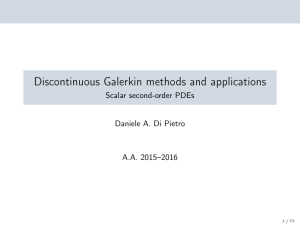PROCESS AND SKILLS
advertisement

Process, Phases and Skills Proses kaunseling mempunyai suatu jangka masa untuk membolehkan klien berubah. Proses kaunseling diikuti dengan kaedah atau langkah tertentu. Proses kaunseling mementingkan perhubungan terbuka antara pembimbing atau pengamal kaunseling dan klien. Kaunseling memerlukan pemahaman tentang ilmu psikologi. The concept of process is widely used in discussions of the experience of what actually happens in counseling. Process refer to a sense of change, movement and activity within the counseling session. Three broad phases: beginning, middle and end. Some of the key factors in the opening phase of counseling are the negotiation of expectations, assessment of the client and the formation of a therapeutic relationship. The middle phase of counseling is the stage where most learning and change occurs. The key processes at the ending phase of counseling are dealing with maintenance of learning and referral. Attending Rapport Listening Understanding Problem solving Decision making Action Termination Client becomes aware of an issue A sense of urgency develops Clients begin to look for remedies The cost of pursuing different solutions begin to emerge A more serious weighing of choices take place An intellectual decision is made to accept some choice The heart joins the head in the decision The Egan model aims to help the clinet address 3 main questions: 'What is going on?' 'What do I want instead?' 'How might I get to what I want?' Stage 1: Stage 2: Stage 3: Current Scenario Preferred Scenario Action Strategies Current Scenario What's going on? What's really going on? Focusing/Prioritising WHAT IS GOING ON? The helper encourages the speaker to tell their story, and by using good active listening skills and demonstrating the core conditions, helps them to explore and unfold the tale, and to reflect. Skills:-active listening, reflecting, paraphrasing, checking understanding, open questions, summarizing. Useful Questions: How do/did you feel about that? What are/were you thinking? What is/was that like for you? Keep them open! What else is there about that? Useful Questions: How do others see it/you? Is there anything you've overlooked? What does he/she think/feel? What would s/he say about all this? What about all of this is a problem for you? Any other way of looking at it? Skills: Facilitating focusing and prioritizing an area to work on. Useful Questions: What in all of this is the most important? What would be best to work on now? What would make the most difference? What is manageable? WHAT DO YOU WANT INSTEAD? Useful Questions: What do you ideally want instead? What would be happening? What would you be doing/thinking/feeling? What would you have that you don't have now? What would it be like if it were better / a bit better? Skills: facilitating selecting and reality checking with respect to internal and external landscape. Useful Questions: What exactly is your goal? How would you know when you've got there? What could you manage/are you likely to achieve? Which feels best for you? Out of all that, what would be realistic? When do you want to achieve it by? Skills: facilitation of exploring costs and benefits, and checking commitment to goal. Useful Questions: What will be the benefits when you achieve this? How will it be different for you when you've done this? What will be the costs of doing this? Any disadvantages/downsides to doing this? Skills: Facilitation of brainstorming Useful Questions: How many different ways are there for you to do this? Who/what might help? What has worked before/for others? What about some wild ideas? Skills for Stage 3: Facilitation of selecting and reality checking. Useful Questions: Which of these ideas appeals most? Which is most likely to work for you? Which are within your resources/control? Skills: Facilitation of action planning. Useful Questions: What will you do first? When? What will you do next? When? FEM3107/PEM3501 SEM 2, 2010/11 STAGE 1: STAGE 2: Attending Exploration STAGE 3: Understanding STAGE 4: Action STAGE 5: Termination Peterson & Nisenhoiz (1990), bassed on Carkhuff (1983), Egan (1982), Ivey (1983), Brammer (1979) Pre session and relationship building Problem exploration and goal setting Deciding on strategy and action plan Termination Follow up Relationship Establishment Problem Identification and Exploration Planning for Problem Solving Solution Application and termination Stage 1 Stage 2 Stage 3 Building a relationship Working in a relationship Termination of relationship READ this sentence: “FINISHED FILES ARE THE RESULTOF YEARS OF SCIENTIFIC STUDYCOMBINED WITH THE EXPERIENCE OF YEARS”. Now count aloud the F's in that sentence. Count them ONLY ONCE; do not go back and count them again Structure Initiative The physical Setting Client Qualities Counselor qualities Preparation Helper Attitude, worldview Theory, skills, limitation Physical environment Conducive, safe, quiet, privacy, recorder Documentation Case report, questionnaire, etc Done by staff What information you want to know To tell more about client Such as demographic information For statistic In certain case, no intake interview Welcome –energy Opening statement –‘I feel good to have you’ Initiate interview process Invite helpee/client to talk - Tell me something about you? - What brings you here? - Information or relationship orientation Attending skills Structuring Welcome the client Tell the client he or she is here for a counseling session Explain the counseling process Design to relieve tensions and open communication Invite client to talk Attractiveness Punctuality Attending to client –comfortable assertiveness - verbal: “ASM, apa khabar dan selamat datang, saya …. - Physical: Draw closer, shake hand - Psychological : eye contact, smile Verbal - Clearly state what you want to know or what you understood - Counseling microskills –paraphrase, reflection, etc Non verbal - Unspoken action to communicate what is not said (but is there!) Egan (1988) SOLER S -face the client squarely O -adapt an open posture L –leaning forward E –Eye contact R -Relax Facial expression Voice quality Gestures and movements Helper and helpee Client/Helpee Check out procedure Test relationship Is cautious States concerns Present Problem Helper –provides working environment - clarify process - Attend to client and self - Observes, listen, accept A T T E N D I N G Exploration Know and understand the problem Tree not branches Developing goal Stating the goal Understand of a client Exploration Integrate the information Identify mental disorders (IF ANY) Identify the REAL problem Question that embarrass, challenge, or threaten the client are avoided Client / Helpee - Begins to explore, less defensive, - Problem gets clearer, aware of feelings, more self disclose Helper: Establish trust, show concern and caring, empathy, respect, warmth, feedback, summarizes E X P L O R A T I O N Define the problem Identify and list all possible solutions “have you also thought of------?” Explore the consequences of the suggested solutions Prioritize the solutions Generating alternatives or choices Problem solving Decision making Tentative action plan Client/ Helpee Take responsibility of problem, strengthen commitment, develop insight, understand problem Helper: Help personalize problem, confronts, advanced empathy, probes. direct, interprets U N D E R S T A N D A final action plan Plan B –as contingency Ending Termination Issue: When to terminate? Client initiated, session completed Terminate relationship Take action Encourage client’s acting on his/ her determined problem solution Counselor often maintain contact as a source of follow-up, and support Client / Helpee Put idea into action, clarify thought and feelings, set goals, implement t plan, evaluate Helper: Help generate, evaluate alternatives, help client decide, encourage, feedback A C T I O N Discussion of the end of counseling Review of the course of counseling Closure of the counselor-client relationship Discussion of the client’s future postcounseling plans Plan B – as contingency Ending FEM3107/PEM3501 SEM 2, 2010/11 All this process usually stretched to several session But can also done in one session Brief counselling Single session Peterson & Nisenhoiz (1990), bassed on Carkhuff (1983), Egan (1982), Ivey (1983), Brammer (1979) Client/ Helpee Evaluates gains, acknowledge changes, plans contingency Helper: Help complete process, assess readiness for ending, affirm, feedback, follow up T E R M I N A T E 1. 2. The average woman would rather have beauty than brains, because the average man can see better than he can think. Smart man + smart woman = romance Smart man + dumb woman = pregnancy Dumb man + smart woman = affair Dumb man + dumb woman = marriage 3. A man will pay $2 for a $1 item he needs. A woman will pay $1 for a $2 item that she doesn't need. 4. A woman has the last word in any argument. Anything a man says after that is the beginning of a new argument. NOTA SK2 PROSES KAUNSELING 3 TAHAP: TAHAP 1 : SITUASI MASALAH - MENEROKA DAN MEMAHAMI ISU @ MASALAH TAHAP 2 : SENARIO YG DIHARAPKAN - MENJANA HALA TUJU KLIEN TAHAP 3 : PLAN TINDAKAN - MEMBINA LANGKAH PENYELESAIAN NOTA SK2 NOTA SK2 MEWUJUDKAN HUBUNGAN ANTARA KAUNSELOR-KLIEN - KAUNSELOR MELAYAN KLIEN UTK RASA SELESA DAN DILAYAN MEMBAWA KLIEN MENEROKA ISU ATAU PERMASALAHAN DIRI - MEMBANTU KLIEN MENEROKA PERISTIWA, PEMIKIRAN, PERASAAN DAN TINDAKBALAS KLIEN NOTA SK2 MEMBAWA KLIEN MEMAHAMI SITUASI DIRI SITUASI PERMASALAHAN CARAGAYA BERFIKIR, BERPERASAAN DAN BERTINDAK SENARIO PERSEKITARAN MELIBATKAN SETING TEMPAT KERJA, FAMILI, JIRAN TETANGGA DAN KOMUNITI NOTA SK2 MENGAJAK KLIEN MEMBINA PLAN TINDAKAN KLIEN DIJANA UTK MENGGARISKAN STRATEGI TINDAKAN KLIEN DIBANTU MENYUSUN LANGKAHLANGKAH KECIL DAN BESAR NOTA SK2 NOTA SK2 Menyediakan suasana yang sesuai dan kondusif seperti bilik dan tempat duduk yang selesa Peringkat permulaan hubungan antara kaunselor dan klien Klien harus merasa selesa dan selamat dalam perhubungan ini Kaunselor mengamalkan sikap empati dan menerima tanpas yarat agar klien rasa dihargai dan dihormati Wujudkan kepercayaan yang teguh agar klien yakin bahawa kaunselor benar-benar ingin membantu NOTA SK2 Penstrukturan bertujuan untuk mendefinisikan jenis kaunseling, batasan dan matlamat sesi kaunseling Membincangkan peranan/komitmen kaunselor dan klien Menyatakan tentang batasan etika dan masa yang akan diambil bagi sesuatu sesi dan keseluruhan proses Bagi kaunseling berpendekatan tingkah laku,kontrak mungkin diperlukan bagi memastikan klien melakukan tugasan NOTA SK2 Merupakan peringkat penerangan klien tentang masalah yang dihadapi Lazimnya klien akan bercerita dengan mudah.Tetapi ada masanya klien mungkin kurang kerjasama terutamanya jika dirujuk Kaunselor perlu membimbing klien bercerita dengan jelas dan tentang perkara yang berkaitan sahaja Adakalanya memerlukan masa yang agak lama,oleh itu kaunselor harus bersabar dan mendengar dengan teliti NOTA SK2 Klien mungkin sama ada: i) Tidak sedar tentang punca masalahnya ii) Keliru dengan situasi yang menimpanya atau iii) Tidak dapat memikirkan cara mengatasi masalahnya dengan jelas Penerokaan dilakukan daripada segala aspek isi (pengalaman) dan perasaan/cara pemikiran/tingkahlaku klien Pemahaman yang mendalam akan memudahkan kaunselor mengenalpasti masalah sebenar yang dihadapi oleh klien NOTA SK2 Kaunselor akan menggunakan kemahiran untuk mengenalpasti masalah sebenar klien Adakalanya masalah yang diketengahkan pada awal sesi bukan masalah sebenar kerana klien adakalanya suka mereka cerita atau tidak tahu dari mana hendak memulakan Selepas penerokaan barulah cerita sebenar dikenalpasti dan masalah didefinisikan NOTA SK2 Klien diajak/digalakkan memikirkan sendiri alternatif yang dirasakan sesuai dan terbuka untuknya. Kaunselor boleh menimbulkan celik akal bagi mewujudkan alternatif baru yang mungkin tidak difikirkan oleh klien. Pilihan alternatif bukan paksaan kerana klien perlu tahu risiko setiap alternatif yang dipilihnya. Alternatif disusun mengikut keutamaan agar mudah dilaksanakan. NOTA SK2 Setelah alternatif dipilih bincangkan langkahlangkah yang sesuai untuk menjalankannya. Perancangan haruslah teliti agar kemungkinan berjaya adalah tinggi. Klien diajak memikirkan risiko yang mungkin berlaku (positif dan negatif). Perancangan yang berkesan ialah perancangan yang jelas tetapi flesibel iaitu boleh diubah suai mengikut keadaan. NOTA SK2 i) Kaunselor mungkin perlu mengajar klien tingkahlaku baru atau pemikiran baru kepada klien. ii) Klien diharapkan akan menjalankan tindakan yang telah dirancang semasa di luar sesi. Ramai klien gagal mengambil tindakan kerana halangan peribadi. Ada yang takut situasi menjadi lebih buruk,takut untuk mencuba atau lebih selesa berserah dan mengharapkan situasi berubah dengan sendiri tanpa berusaha. NOTA SK2 Bermaksud kaunselor dan klien bertemu semula di sesi yang lain untuk membincangkan semula alternatif atau kesan daripada tindakannya. 3 kemungkinan senario yang dibawa klien: a) Klien gagal/tidak mengambil tindakan b) Klien mengalami kesan negatif daripada tindakan c) Klien mengalami kesan positif daripada tindakan NOTA SK2 i) Sesi tidak boleh diberhentikan secara tergesa-gesa. ii) Penamatan mungkin berlaku kerana: i) Matlamat telah dicapai ii) Klien tidak mahu meneruskan sesi iii)Matlamat tidak dapat dicapai dan perlu buat rujukan kepada kaunselor lain Rumusan tentang apa yang dibincangkan perlu dibuat Kaunselor juga perlu menilai keberkesanan sesi dengan berbincang dengan klien


